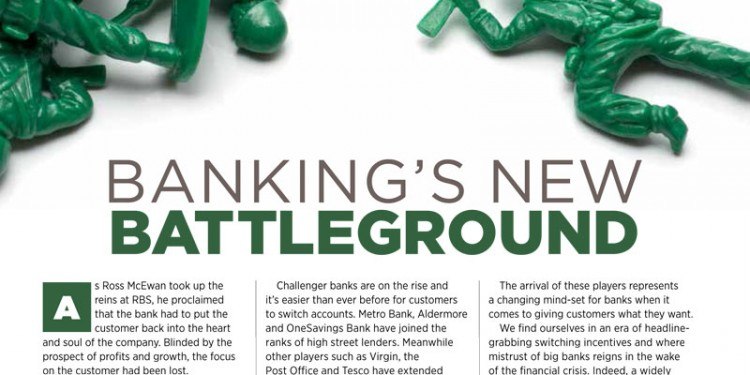In an increasingly competitive marketplace, banks need to work harder to earn customer loyalty – by starting at the very beginning. JAN-PIETER LIPS explains.
View the printed version by downloading the PDF.
As Ross McEwan took up the reins at RBS, he proclaimed that the bank had to put the customer back into the heart and soul of the company. Blinded by the prospect of profits and growth, the focus on the customer had been lost. ‘We will reward our customers for loyalty and stop giving the best deals only to those who switch banks,’ McEwan stated, while pledging a return to ‘the basics’. This is absolutely the right model for high street banks. Considering the headlines dominating the banking landscape of late, it is clear we are faced with a new banking battleground. Challenger banks are on the rise and it’s easier than ever before for customers to switch accounts. Metro Bank, Aldermore and OneSavings Bank have joined the ranks of high street lenders. Meanwhile other players such as Virgin, the Post Office and Tesco have extended their scope to include mainstream banking services.
NEW BANKS ON THE BLOCK
And it’s not just the mainstream banking services experiencing disruption. Atom Bank plans to be the UK’s first all-digital lender, while soon a new unnamed bank backed by WPP will be targeted at the millennial generation. A The arrival of these players represents a changing mind-set for banks when it comes to giving customers what they want. We find ourselves in an era of headlinegrabbing switching incentives and where mistrust of big banks reigns in the wake of the financial crisis. Indeed, a widely held view is that it will take at least a decade for the established banks to regain a trusted reputation. In this environment, more needs to be done to get back to the roots of banking, when the customer was the priority. This means a personalised experience where customers feel rewarded and understood. Recent Aimia research highlights this challenge: only 9% of UK customers stick with their bank because they get rewarded for their loyalty. This is in stark contrast to supermarket customers, 28% of whom will remain loyal to their supermarket because they are rewarded.
CUSTOMERS ARE MORE SAVVY
The days of banks relying on apathy as a source of customer loyalty also look numbered. A year ago 20% of customers said they remained loyal to their banks because they couldn’t be bothered to change. Now, only 11% can’t be bothered to change banks. Customers are waking up, while banks have been caught napping. Modern loyalty means winning more repeat business than your competitors by creating a more engaging, targeted and rewarding experience over the long term. In a sense, this means taking it back to the very beginning of banking, or ‘the basics’, as McEwan said. Staff at a small local branch would have known their customers by name, anticipated their needs and rewarded their best customers. With the explosion in big data, banks actually have more means than ever before to fulfil what loyalty promises – making business personal so that customers keep coming back. In an ideal world banks should transform the data at their fingertips into customer understanding and use that to drive better decisions for their customers. But all too often this isn’t happening. Indeed poor targeting by banks continues to undermine the customer relationship. Only one in three people say that the offers they receive from their bank are relevant to them. Contrast that with nearly 60% of supermarket customers who agree with that statement. For customers entrusting banks with their valuable data, they should rightly feel that they can gain relevant communications and products in return. And banks may be missing a beat – 64% of consumers would be interested in opting-in to a service that would give them relevant offers and discounts directly on their bank card, based on where they shop.
CUSTOMERS STILL TRUST BANKS
This is partly because customers trust banks with their data. Banks seem safe. When asked which organisations they feel most comfortable with to handle their personal data, the majority of consumers (41%) ranked financial service providers top, with 25% choosing supermarkets and 21% choosing their employer. With all this data, this should feel like the golden age for marketing. But it doesn’t always seem that way. Customers have given companies the ingredients – and the permission – to make them feel special. But thus far, most banks haven’t seized this opportunity. So, what can banks do to provide a rewarding, personalised experience, keep their customers coming back and stem the flow to rivals? First they must truly understand their customers. Because everything they do needs to be driven by them. This means knowing what channels consumers like to be communicated through, when they like to be engaged, what offers they would consider relevant, and how they like to be rewarded – essentially, viewing customers as individuals, rather than as part of a general mass. Data analytics clearly has a huge role to play, but it is more than that. It is about utilising the insights garnered to effectively engage and value customers through perfectly targeted rewards. It is about delivering exactly what a customer wants, and then rewarding that customer for doing so. Ross McEwan was right. In the rush for growth, banks forgot what banking is all about: serving the customer. But it’s more than taking it back to basics. With all the innovations at our disposal, it’s about enhanced basics. Banks that realise this will be the winners over the long term.

